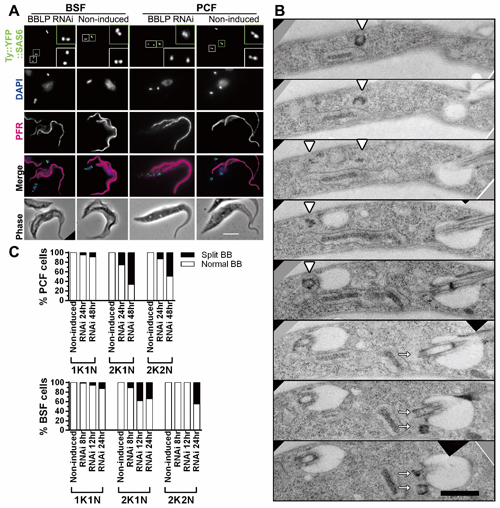The first centriolar linker specific protein (BBLP) was discovered in human pathogen of Trypanosoma brucei
Source: School of Life Sciences
Edited by: Tan Rongyu, Wang Dongmei
Centrioles and basal bodies (BBs) are found in physically linked pairs, and in mammalian cells inter-centriole connections (G1-G2 Tether and S-M Linker) regulate centriole duplication and function [Dawe et al., 2007; Nigg and Stearns, 2011]. Studies have revealed essential components of the Tether whilst Linker components remain largely unknown [Fang et al., 2014; Xia et al., 2018].
Trypanosoma brucei, the pathogen of human African trypanosomiasis (sleeping sickness) distributes mainly in Africa. A large number of biological characteristics, for instance the BBs are not associated with the spindle and function in flagellum/cilia nucleation with an additional role in mitochondrial genome (kDNA) segregation [Robinson and Gull, 1991], which have made
T. brucei an excellent model for centrosome studies.
BBLP, a novel BB/pro-Basal Body (pBB) linker protein in
T. brucei was identified and predicted to be a large coiled-coil protein conserved in the kinetoplastida. Co-localization with the centriole marker SAS6 showed that BBLP localizes between the BB/pBB pair, throughout the cell cycle, with a stronger signal in the old flagellum BB/pBB pair. Importantly, RNAi depletion of BBLP leads to a conspicuous splitting of the BB/pBB pair associated only with the new flagellum (Figure 1). BBLP RNAi is lethal in the bloodstream form of the parasite, and perturbs mitochondrial kDNA inheritance. Immunogold labelling confirmed that BBLP is localized to a cytoskeletal component of the BB/pBB Linker, and tagged protein induction showed that BBLP is incorporated de novo in both new and old flagella BB pairs of dividing cells.

Figure 1, Early phenotype of BBLP RNAi. (A) As early as 8 hour after induction of BBLP RNAi. B) Transmission electron microscopy analysis of serial sections of an induced cell. C) Quantification of the BB splitting phenotype at different times post-induction of BBLP RNAi.
In addition, two aspects of CBB disengagement – loss of orthogonal orientation and ability to separate and move apart – are consistent, but separable events in evolutionarily diverse eukaryotic cells. Therefore, a unifying model explaining centriole/BB linkage differences between such cells were provided (Figure 2), which reveals how aspects of centriole/BB ontogeny and lineage can operate at different points of the cell cycle in evolutionarily diverse cells.
Figure 2, Models of centriole and basal body Linker in mammalian and trypanosome cell cycles. 1 and 2, parent centrioles (basal bodies); 3 and 4, pro-centrioles (pro-basal bodies); Linker is indicated in red.
This work is done based on a long term collaboration with Professor Keith Gull CBE DSc(Hon) FRS FMedSci FSB from the Oxford University, and Researcher Flavia Moreira-Leite from the Oxford Brookes University in the United Kingdom, Dr. De-Hua Lai’s group from the School of Life Sciences at Sun Yat-sen University published their results in a peer review journal PNAS with the entitled " A specific basal body linker protein provides the connection function for basal body inheritance in trypanosomes [Lai et al., 2021]. This work was funded by grants from the National Natural Science Foundation of China [31402029 and 31772445 to D.-H.L.]; Natural Science Foundation of Guangdong Province [2014A030313164 and 2016A030306048 to D.-H.L.] D.-H.L. was a Marie Curie fellow supported by PIIF-GA-2009-252589. Work in K.G.’s laboratory was supported by the Wellcome Trust grants [WT066839MA] and [104627/Z/14/Z].
References:
Dawe HR, Farr H, & Gull K (2007) Centriole/basal body morphogenesis and migration during ciliogenesis in animal cells.
J Cell Sci 120(Pt 1):7–15.
Fang GL, et al. (2014) Centlein mediates an interaction between C-Nap1 and Cep68 to maintain centrosome cohesion.
J Cell Sci 127(8):1631–1639.
Lai DH, Moreira-Leite F, Xu ZS, Yang J, Gull K (2021) A specific basal body linker protein provides the connection function for basal body inheritance in trypanosomes.
Proc Natl Acad Sci USA 118(8): e2014040118.
Nigg EA & Stearns T (2011) The centrosome cycle: Centriole biogenesis, duplication and inherent asymmetries.
Nat Cell Biol 13(10):1154–1160.
Robinson DR & Gull K (1991) Basal body movements as a mechanism for mitochondrial genome segregation in the trypanosome cell cycle.
Nature 352(6337):731–733.
Xia Y, et al. (2018) CCDC102B functions in centrosome linker assembly and centrosome cohesion.
J Cell Sci 131(23):jcs222901.
Link to the paper:
https://doi.org/10.1073/pnas.2014040118
